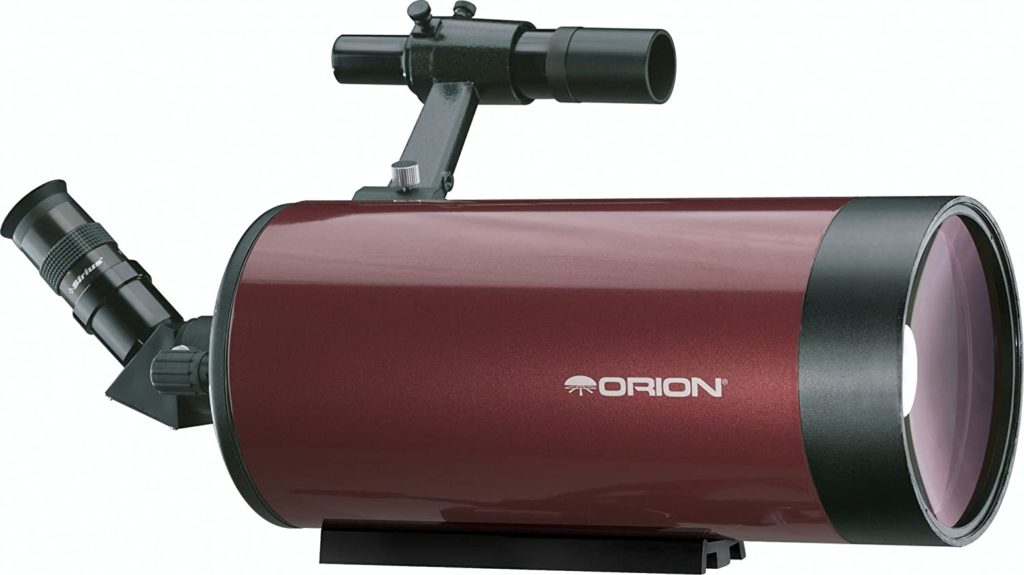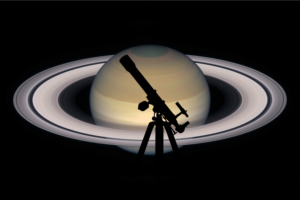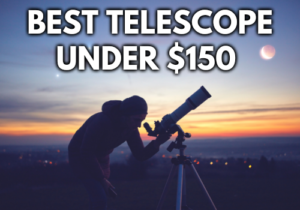Best Maksutov Cassegrain Telescope; Mak-Cass Reviews
Disclosure: This post contains affiliate links and I may earn a small commission (at no extra cost to you) if you click through and make a purchase. Thanks in advance – I really appreciate it!
Here in this “Best Maksutov Cassegrain Telescope” article we’ve rounded up 8 of the best telescopes of various types, specifications, and budget. Below, you’ll find in-depth reviews of each to help you pick out the one that suits you the most.
COMPARISON TABLE
| Image | Title | Best For | Features | Price | Buy |
|---|---|---|---|---|---|
Top Top
Top
Top
Top Top
Top
Top
Top | Celestron - NexStar 127SLT | Best Rated | Type: Maksutov-Cassegrain, Aperture: 127mm (5″), Focal length: 1500mm, Focal Ratio: f/12 | See on Amazon | |
 Top
Top
Top
Top
Top
Top | Orion 8869 | Best Professional | Type: Maksutov-Cassegrain, Aperture: 180 mm(7.1″), Focal length: 2700mm, Focal Ratio: f/15 | See on Amazon | |
 Top
Top
Top
Top
Top
Top | Celestron - NexStar 4SE | Best GoTo | Type: Maksutov Cassegrain, Aperture: 102 mm / 4.1″, Focal length: 1325 mm, Focal Ratio: f/13 | See on Amazon | |
 Top
Top
Top
Top
Top
Top | Orion 9820 | Best Intermediate | Type: Maksutov-Cassegrain Aperture: 90mm(3.54″) Focal length: 1250mm Focal Ratio: f/13.9 | See on Amazon | |
 Top
Top
Top
Top
Top
Top | Sarblue Maksutov-Cassegrain Telescope | Best For Kids | Type: Maksutov-Cassegrain Aperture: 60mm(2.36″) Focal length: 750mm | See on Amazon | |
 Top
Top
Top
Top
Top
Top | Meade Instruments – ETX125 Observer | Best For Astrophotography | Type: Maksutov-Cassegrain, Aperture: 127mm (5″), Focal length: 1900mm, Focal Ratio: f/15 | See on Amazon | |
 Top
Top
Top
Top
Top
Top | Orion StarSeeker IV 80mm | Best For Moon & Planets | Type: Maksutov-Cassegrain, Aperture: 127mm(5″), Focal length: 1540mm, Focal Ratio: f/12.1 | See on Amazon |
Product prices and availability are accurate as of the date/time indicated and are subject to change. Any price and availability information displayed on [relevant Amazon Site(s), as applicable] at the time of purchase will apply to the purchase of this product.
Prices pulled from the Amazon Product Advertising API on:Maksutov-Cassegrain telescopes provide a spectacular viewing experience in a compact design, offering a superior contrast that makes them excellent telescopes for planetary and double star observing.
Also known as Mak-Cass telescopes, these telescopes appear similar to Schmidt-Cassegrain telescopes, but they differ slightly in design and are typically available with smaller apertures between 3.5 and 7.1 inches.
Like SCTs, Maksutov-Cassegrain telescopes are reflecting telescopes with a catadioptric design that uses both lenses and mirrors to minimize aberrations.
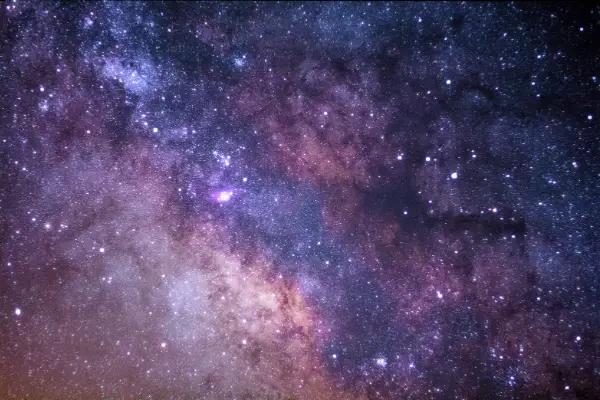
How Do Maksutov Cassegrain Telescopes Work?
Maksutov-Cassegrain telescopes are a catadioptric design, meaning they use both lenses and mirrors. Mak-Casses are primarily reflecting telescopes, but they use a corrector lens to eliminate aberrations that would result from the mirror design alone.
In a Mak-Cass the incoming light passes through the Maksutov corrector lens (sometimes called a meniscus corrector, because of its shape) at the front of telescope. It is reflected from a concave primary mirror at the back of the scope which focuses the light to the front of the telescope where it is reflected again by a smaller, convex secondary mirror.
Finally, the light travels back through a hole in the primary mirror to the rear of the scope where an eyepiece is located for visual observing (or a camera for photographing).
By folding the light in this manner, a Mak-Cass can be made much smaller than an equivalent Newtonian or refractor.
Advantages Of Maksutov Cassegrain Telescope.
They are compact and easy to transport. And the higher magnification will darken the washed-out city sky and bring out more contrast in deep-sky objects.
They are rugged and robust, so Maksutov-Cassegrains are used in harsh environments in industrial and military applications. But because the corrector lens on a Mak is quite thick, these scopes get heavy at higher apertures.
These scopes have superb mechanics and razor-sharp optics almost without aberration.
Best Mak-Cass Telescopes
Best Rated Maksutov Cassegrain Telescope
Celestron – NexStar 127SLT
- Type: Schmidt-Cassegrain
- Aperture: 127mm (5″)
- Focal length: 1500mm
- Focal Ratio: f/12
- Mount: Computerized Alt-az
- Eyepiece: 25mm, 9mm
- Magnification: 60x, 167x
- Weight: 18.0 lbs.(8.2 kg)
- Our Rating: 9.6/10
Prices pulled from the Amazon Product Advertising API on:
Product prices and availability are accurate as of the date/time indicated and are subject to change. Any price and availability information displayed on [relevant Amazon Site(s), as applicable] at the time of purchase will apply to the purchase of this product.
The Celestron NexStar 127SLT is an entry-level GoTo telescope designed for anyone looking for a reliable telescope with which to enjoy the nighttime sky.
The telescope features a 127mm aperture and Celestron’s SkyAlign technology, this telescope offers consumers good views. In addition, the telescope’s single fork arm and simple design make it easy to set up and use.
The scope’s focal length is 1500mm, and it has a focal ratio of f/12. As far as eyepieces are concerned, each Celestron NexStar 127 SLT telescope comes with a 25mm eyepiece and a 9mm eyepiece, having a maximum magnification of 167x with the default 9 mm eyepiece.
The Celestron NexStar 127 SLT telescope stands on top of a motorized Altazimuth mount, which can be controlled via the provided digital hand controller.
Alternatively, the mount can be hooked to a computer for increased precision.
With preassembled, adjustable stainless steel tripods, and quick release fork arms and tubes, the NexStar 127 SLT telescope can be set up in a matter of minutes with no tools required.
The 127 SLT with its large aperture is great for viewing the surface of the moon, phases of Venus, rings of Saturn or Jupiter and its four largest moons, and other deep-space objects.
The Celestron NexStar 127SLT is also the best computerized maksutov cassegrain telescope for astrophotography.
The Celestron NexStar GoTo mounts are powered by eight AA user-supplied batteries, or an optional AC adapter, making them perfect as a travel telescope.
With Celestron’s SkyAlign Technology, aligning your telescope is fast and easy. Simply input the date, time and location (the CPC models have built-in GPS that does this for you) and then align the telescope to three bright stars of your choosing.
You do not need to know the names of the stars, you can even pick the moon or bright planets. The NexStar computer system will automatically figure out which stars were chosen and then align the telescope.
The 127SLT’s diagonal is a prism, and a nice one at that – unlike the cheap diagonals supplied with many entry-level scopes which are cheap mirrors that aren’t very flat, which tend to offer dim and fuzzier images.
Pros:
- Super optical construction
- Very easy to operate with
- Compact and portable design
- Included needed additional accessories
- Suitable for lunar/planetary astrophotography
Cons:
- 8 AA batteries required but not included
- Tripod can be more stable
Best Professional Pick
Orion 9969
- Type: Maksutov-Cassegrain
- Aperture: 180 mm(7.1″)
- Focal length: 2700mm
- Focal Ratio: f/15
- Mount: Only OTA
- Weight: 15.9 lbs. (7.21 kg)
- Our Rating: 9/10
Prices pulled from the Amazon Product Advertising API on:
Product prices and availability are accurate as of the date/time indicated and are subject to change. Any price and availability information displayed on [relevant Amazon Site(s), as applicable] at the time of purchase will apply to the purchase of this product.
The Orion 9969 possesses a whopping 7.1″ aperture and 2,700mm focal length (f/15) Maksutov-Cassegrain excels for high-power solar system viewing and photography of the Moon and planets.
Typical f/15 and 7 inch aperture scopes are about 1000mm long and have a focal length of 1000mm. Compare this to the Mak, which has a 2700mm focal length! The focal length determines how wide a field of view you can achieve (which is also dependent on camera sensor size, but we’ll assume that we use an identical camera.).
A wide field of view allows you to capture larger objects in the sky, such as nebulae or constellations rather than being limited to smaller nebulae and galaxies with longer F/ratio telescopes.
A smaller field of view, like the one you will get with the Mak, can be useful for targeting smaller deep-sky objects, or ideally lunar and planetary targets.
The scope has a heft and seriousness to it. At 15 lbs, the scope will work on an AVX-class mount. With the 8X50 finder, diagonal, and eyepiece installed, it will just barely balance with the mount’s supplied 11 lb counterweight. So mechanically, you can treat the thing as you would a conventional 8″ SCT.
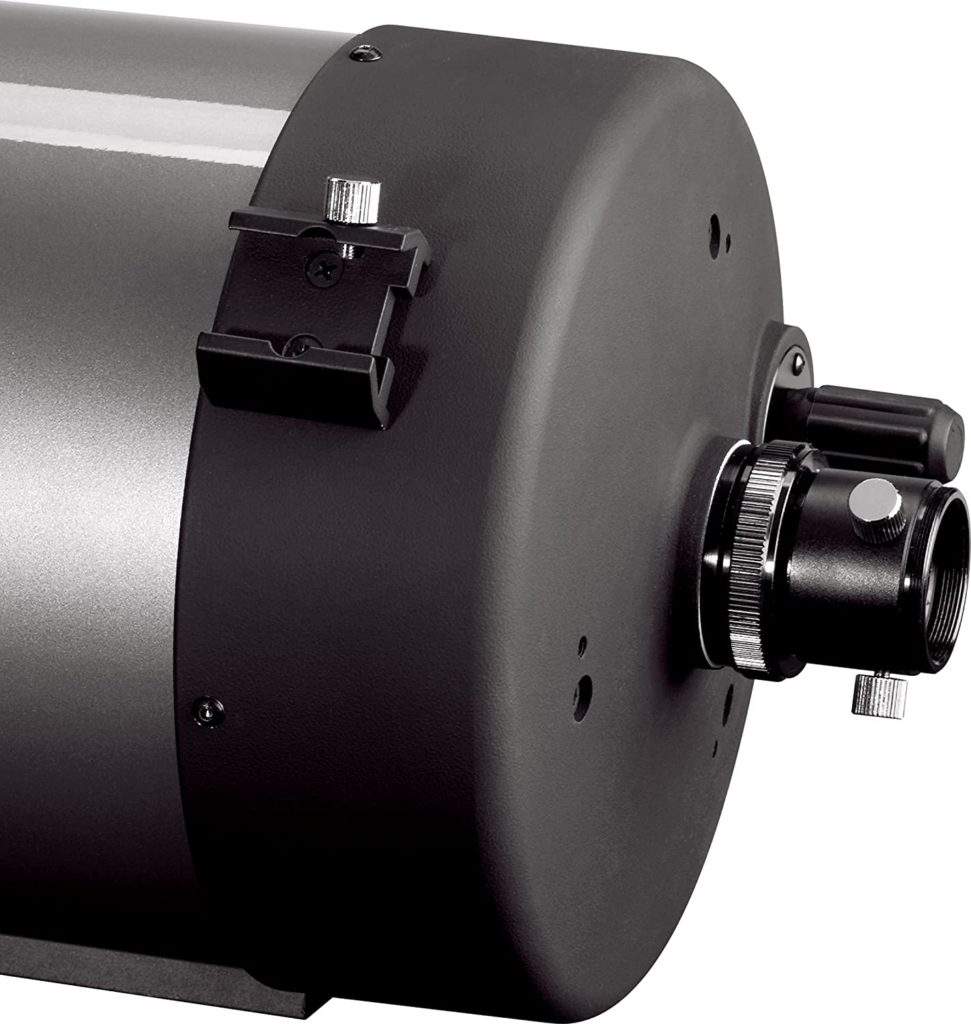
The Orion 180mm Maksutov-Cassegrain comes with a 2″ visual back, so it can accommodate a 2″ diagonal and 2″ eyepieces.
Moreover, the threads on which the 2″ visual back attaches itself are SCT (Schmidt-Cassegrain telescope) threads, which are 2″ diameter x 24 TPI male threads. So you can remove the visual back to thread on an optional SCT-specific diagonal or camera adapters designed for SCT threads.
Along with the 2″ visual back it also comes with a 2″ to-1.25″ step down adapter to allow use of 1.25″ accessories, if required.
Its large 180mm aperture will give you 44% greater light grasp, and you’ll get brighter images and better resolution.
It’s rare to find such potent optical specifications in a package that measures just 22″ long and weighs in at less than 16 lbs.
The meniscus lens is fully multi coated for maximum light transmission, further enhancing image brightness.
A large rubber-covered focusing knob on the rear side moves the primary mirror incrementally to enable precise, sharp focus. A dovetail finder base on the rear cell accepts any Orion finder scope or EZ Finder.
The Vixen-style aluminum dovetail rail on the underside of the tube provides a solid connection to any compatible mount.
Pros:
- Excellent optical quality
- Gives highly resolved views of smaller deep-sky objects
- Lightweight & compact
- Portable
Cons:
- Bit pricey
Related
Best GoTo
Celestron – NexStar 4SE
- Type: Maksutov Cassegrain
- Aperture: 102 mm / 4.1″
- Focal length: 1325 mm
- Focal Ratio: f/13
- Mount: Motorized; Alt-Azimuth Single Fork
- Eyepiece: 25mm
- Weight: 21.0 lb (9.5 kg)
- Our Rating: 9.2/10
Prices pulled from the Amazon Product Advertising API on:
Product prices and availability are accurate as of the date/time indicated and are subject to change. Any price and availability information displayed on [relevant Amazon Site(s), as applicable] at the time of purchase will apply to the purchase of this product.
Celestron’s NexStar 4SE 125mm f/13 Maksutov-Cassegrain GoTo Telescope is a powerful, versatile, and user-friendly catadioptric-style scope that can be used for observing everything from the Moon and planets to bright deep-sky objects like stars, galaxies, and nebulae.
The 4SE also has an integrated “flip mirror” at the back, which means that there is a built-in star diagonal which can be retracted to allow light directly out of the back of the telescope and into a camera adapter, usually for a DSLR or mirrorless camera.
Celestron’s NexStar 4SE’s big selling point for this model is the GoTo computer.
You can select from a database of 40,000 night sky objects. When you’ve picked a target, the motorized mount will slew the telescope around to point at the object you’ve chosen.
Click here to read Celestron NexStar 4SE’s full review.
Once in your eyepiece, the motor will track it as it moves across the sky so you don’t lose sight of it.
Theoretically, this is a great solution for the more casual backyard astronomer who is more interested in spending time outside seeing objects than finding them.
The 4SE’s 102mm aperture isn’t huge, but the portability of this rig far outweighs any size limitation. And Celestron’s nicely coated optics make the most of every photon fetched.
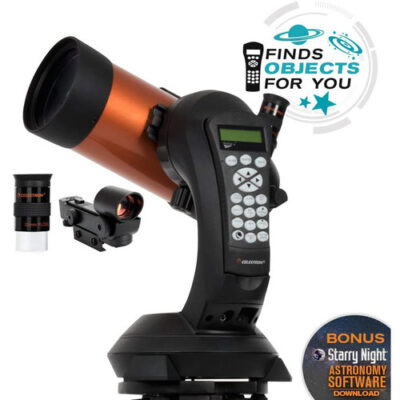
If you want to get your feet wet with astrophotography, the 4SE has a camera control option. It helps you take a series of long duration exposures with your DSLR camera.
Just don’t try to hang a very heavy camera body on this little telescope; an oddly weighted mount won’t track well enough for sharp images.
Because it is a compound telescope, you are going to get picture-perfect images and a wide field of view. Of course, the StarBright XLT coating on the Celestron 4 SE helps, as does the inclusion of a 25 millimeter Plossl eyepiece that delivers 53 times magnification, as well as a 12.5 millimeter eyepiece that can be added to give you 100 times magnification.
As a result, this one of the best telescope under 500 dollars will be powerful enough to capture impressive details of many objects in our solar system, including the Moon, Jupiter, Mars and other planets.
Deep-sky objects, however, will appear less impressive than with a bigger aperture telescope.
The 4SE is so small and light, and the tripod folds so easily, you can quickly jump into almost any vehicle and drive to find dark skies.
And someday, if you grow into a larger telescope, you’ll probably want to keep this one as a “grab-and-go” scope. It’s great for chasing solar eclipses in faraway locations where you can’t lug a lot of luggage.
Pros:
- Very sharp optics
- Quality mount with acceptable gearing
- Acceptable aperture
- Very stable
- Good included low-power eyepiece
- No collimation required
Cons:
- Small aperture for the price
Best Intermediate Mak-Cass Telescope
Orion 9820 Apex
- Type: Maksutov-Cassegrain
- Aperture: 90mm(3.54″)
- Focal length: 1250mm
- Focal Ratio: f/13.9
- Mount: Only OTA
- Eyepieces: 25mm
- Magnification: 50x
- Weight: 3.6 lbs. (1.63 kg)
- Our Rating: 9/10
Prices pulled from the Amazon Product Advertising API on:
Product prices and availability are accurate as of the date/time indicated and are subject to change. Any price and availability information displayed on [relevant Amazon Site(s), as applicable] at the time of purchase will apply to the purchase of this product.
The Orion 9820 is an ideal telescope for scanning the solar system for views of the Moon and planets, as well as globular star clusters and some bright nebulas.
The telescope’s Mak Cass design permits large-diameter optics, 90mm, to be housed in an unusually compact, wonderfully portable tube.
As a spotting telescope the Apex 90mm gathers more light than typical field telescopes, serving up brighter, more highly resolved images even in the dimmest of lighting conditions. Multi-coatings applied to the curved front lens guarantee the highest possible light transmission.
For astronomy, the Apex 90mm Maksutov-Cassegrain Telescope exhibits all the performance of classic long-tube 90mm refractors, and easily outperforms smaller refractors on views of the planets and Moon as well as on faint nebulae and star clusters.
Its long focal length allows high-power study of Jupiter’s cloud belts and Red Spot, and Saturn’s rings, and provides long reach for capturing distant terrestrial targets.
Additionally, Orion 9820 accepts standard 1.25″ telescope eyepieces for nearly unlimited magnification options.
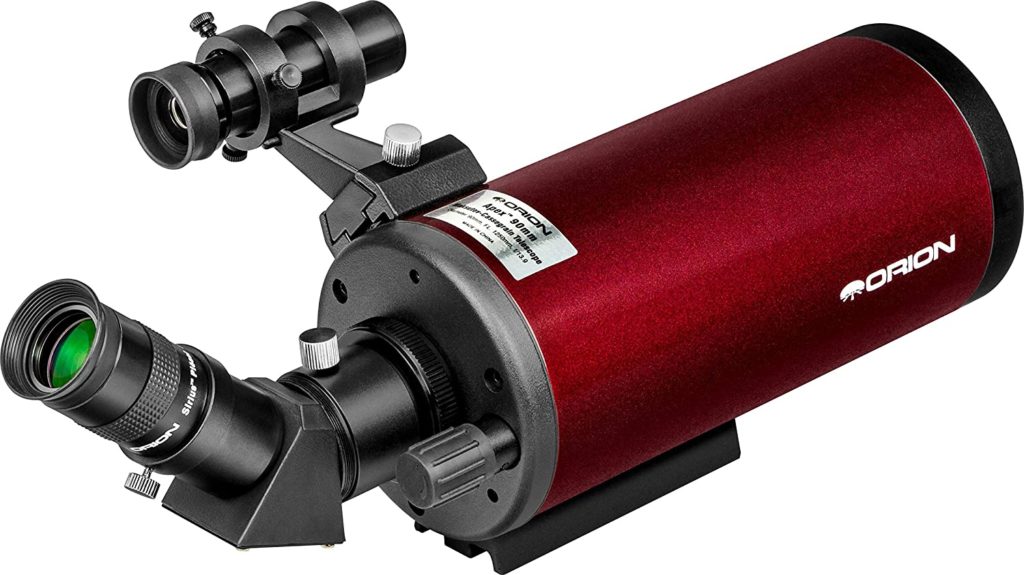
It features a built-in 1/4″-20 adapter plate that makes it easy to mount onto a standard photo tripod for viewing grand daytime vistas.
You can attach a 35mm camera to the scope’s visual back (with a T-ring adapter sold separately) and use the whole assembly as a powerful telephoto lens for astrophotography and terrestrial shooting.
This one of the best maksutov cassegrain telescope comes with a 25mm Sirius Plossl eyepiece, 6×20 correct-image finder scope for accurate aiming during the day or at night, 45-degree correct-image diagonal, soft carry-case, and Starry Night astronomy software. Although it does not include a tripod or mount, which can be purchased separately.
Pros:
- Compact, lightweight & portable
- Excellent optics for the price
- Excellent views of the Moon,planets, & nebulae
- Makes a great spotting scope
- Great for astrophotography
Cons:
- Lacks a mount
Best For Kids
Sarblue Mak60
- Type: Maksutov-Cassegrain
- Aperture: 60mm(2.36″)
- Focal length: 750mm
- Eyepieces: 20mm
- Magnification: 37.5x
- Weight: 2.62 lbs. (1.18 kg)
- Our Rating: 8/10
Prices pulled from the Amazon Product Advertising API on:
Product prices and availability are accurate as of the date/time indicated and are subject to change. Any price and availability information displayed on [relevant Amazon Site(s), as applicable] at the time of purchase will apply to the purchase of this product.
The Maksutov-Cassegrain offers superb optical performance. The design corrects the known optical problems such as coma (found in reflector telescopes) while also correcting chromatic aberration (found in refractors). The result is high-contrast detailed views of both terrestrial or celestial targets.
In a extremely compact tube, the mak60 offers great viewing capacity as a beginner telescope.
The telescope not only delivers vivid high-contrast images for daytime viewing such as birds and wildlife, but also enables astronomical exploration including Saturn, Jupiter, craters on the Moon, etc.
The SARBLUE Mak60 is one of the best maksutov cassegrain telescopes for kids and adults who are beginners in the field of astronomy.
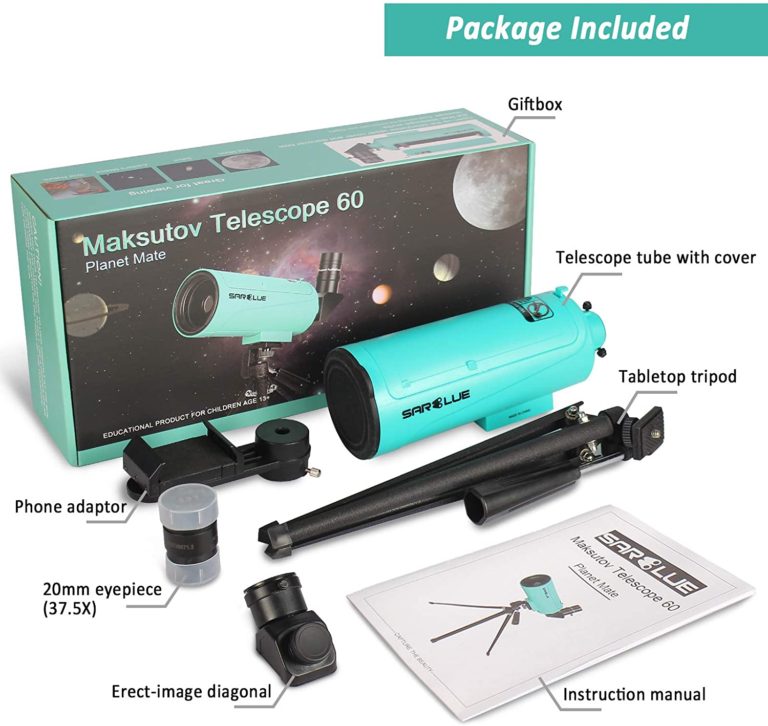
The telescope is designed in such a way that the detachable lid reveals the internal construction of the telescope and helps children and beginners understand the intrinsic working details of the telescopes, making it perfect for gifting it to a budding astronomer.
Moreover, with a long focal length of 750mm, the tube length is only 200mm, which makes it easy to store and carry it to your favorite viewing spot for great views of the night sky.
The telescope comes with a high-quality 20mm wide eyepiece which gives 37.5X magnification, providing high-power sharp views on distant objects.
It also comes with a phone adapter, a tabletop tripod and an erect-image diagonal. The included phone adapter makes it one of the best maksutov cassegrain telescopes for smartphone astrophotography.
Pros:
- Perfect for children
- Lightweight, easy to carry
- Great for iphone/android astrophotography
- Good optics for the price
- Best value telescope
- Great spotting scope
Cons:
- Not for professionals
Best For Astrophotography
Meade Instruments ETX125
- Type: Maksutov-Cassegrain
- Aperture: 127mm (5″)
- Focal length: 1900mm
- Focal Ratio: f/15
- Mount: Computerized; Alt-Azimuth
- Eyepiece: 26mm, 9.7mm
- Weight: 15 lbs.(6.8 kg)
- Our Rating: 9/10
Prices pulled from the Amazon Product Advertising API on:
Product prices and availability are accurate as of the date/time indicated and are subject to change. Any price and availability information displayed on [relevant Amazon Site(s), as applicable] at the time of purchase will apply to the purchase of this product.
The ETX125 Observer is a fully-featured GoTo telescope that includes the AudioStar controller, the heart of this computer guided telescope.
In addition to finding and tracking objects in the night sky for you, the AudioStar controller boasts a number of features of its own, including a 30,000+ object database, built-in speaker, and over 4 hours of audio content that educates you about objects you observe.
AudioStar computer hand control is very simple to operate. It will even help you align the scope on the sky.
All you have to do is tell the AudioStar where and when you are on Earth, level the tube, and show it where North is located using the included bubble level/compass. The AudioStar computer will do the rest.
This slow telescope features a large 127mm aperture and 1900mm (f/15) focal length, making it ideal for planetary, lunar and binary star observation. The ETX125 Observer is also one of the best cMaksutov Cassegrain telescopes that is highly portable too.
The ETX-125 Observer comes with a 26mm Plossl for low power (73x) and a 9.7mm Plossl for high power (196x).
The optics are coated with a special, trademarked substance that allows ultra-high transmission of light, offering bright, high-contrast images with less aberration.
This Maksutov Cassegrain or Mak-Cass telescope, uses a curved corrector plate with the secondary mirror coated directly to it.
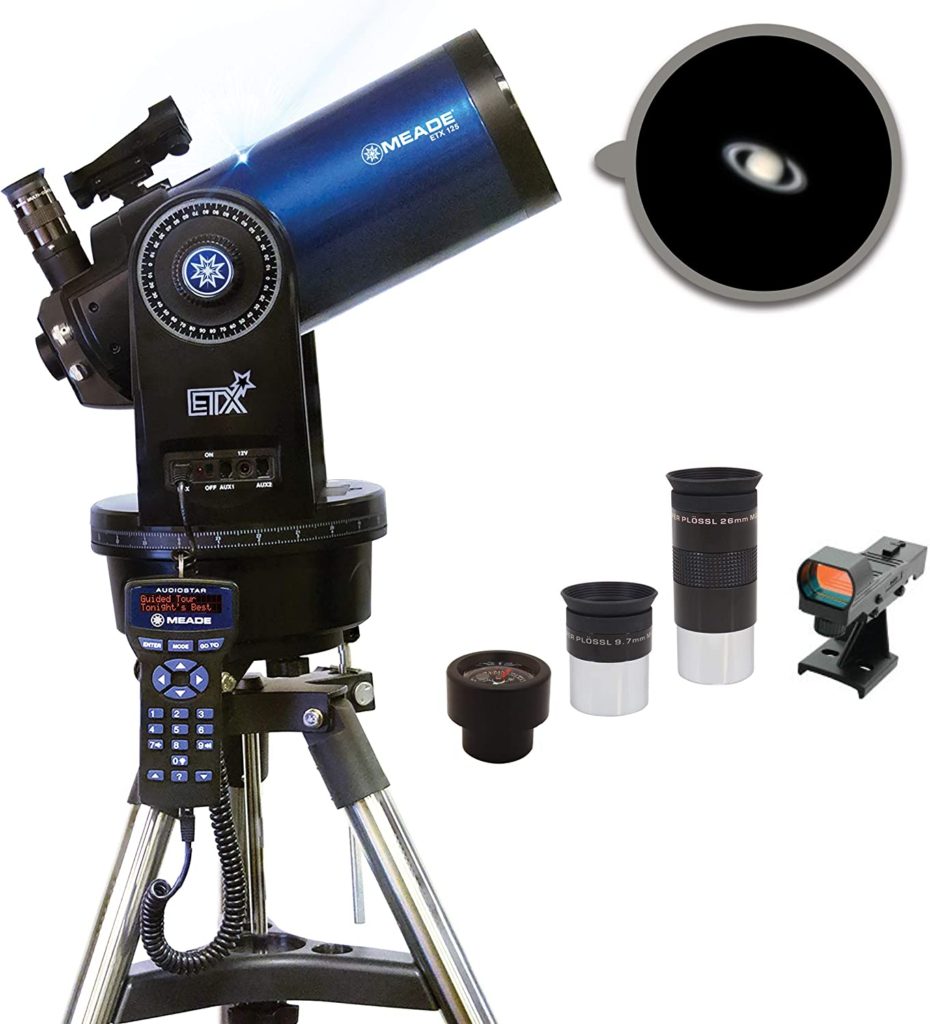
There is no spider or cell to obstruct the light any more than the mirror surface needs and the curved corrector plate helps focus light with a higher accuracy than other designs.
Colors become truer, more light is gathered per aperture, and the contrast is thereby boosted making a Mak-Cass telescope an optimal choice for planetary and lunar observing or imaging.
The portability and easy setup of the Meade ETX125 make it one of the best Mak-Cass telescopes for planetary imaging. The tripod features an EQ Tilt Plate, which further enhances the astrophotography capabilities.
The focal ratio is f/15, making this a very slow telescope. This means you can make some great pictures of bright objects like the Moon, some planets and a few stars if the night sky is perfectly clear.
The red dot finder, the internal flip mirror, and the autostar database will all help you find and identify objects in the night sky to assist you in astrophotography.
The mount of this scope is very unique. It is a Steel Field Tripod that is fairly stable and does not weigh a lot, so it is very portable. The design is technically an altitude-azimuth tripod.
The mount is controlled by the computer via the AudioStar Controller, which allows finding and tracking of objects like planets, stars, nebulae, and galaxies.
The mount features DC Servo Motors which are of good quality in general.
Pros:
- Small, compact & powerful telescope
- GoTo features with a 30,000 object database
- High-Quality lenses, great super plossl eyepieces
- Unique hybrid mount that turns from an Alt-Azimuth into an Equatorial Mount
- Bubble Level/Compass Device for easy set-up and quick leveling
- AudioStar controller for learning about each object as you explore.
Cons:
- The focusing knob can be a hassle to adjust
- Small aperture
Best For Moon & Planets
Orion StarSeeker IV
- Type: Maksutov-Cassegrain
- Aperture: 127mm(5″)
- Focal length: 1540mm
- Focal Ratio: f/12.1
- Mount: GoTo
- Eyepieces: 23mm, 10mm
- Magnification: 78x, 180x
- Weight: 26.1 lbs. (11.83 kg)
- Our Rating: 9/10
Prices pulled from the Amazon Product Advertising API on:
Product prices and availability are accurate as of the date/time indicated and are subject to change. Any price and availability information displayed on [relevant Amazon Site(s), as applicable] at the time of purchase will apply to the purchase of this product.
The Orion StarSeeker IV Maksutov-Cassegrain is a complete altaz Go-To system. It consists of a 6-inch telescope and a single-arm computerised Go-To mount with a SynScan V4 handset, mounted on a sturdy stainless steel tripod.
Two 62º apparent field of view eyepieces are included (23mm and 10mm), giving magnifications of 78x and 180x.
A star diagonal, a 2- to 1.25-inch adaptor and an EZ Finder II reflex sight complete the setup.
The telescope attaches to the arm via a built-in Vixen-style bar.
Power is provided by eight AA batteries (there’s an integrated battery compartment in the mount arm) or via a 12V port at the base of the arm.
Featuring a compact, yet large-aperture Maksutov-Cassegrain optical tube with an extra-long 1800mm focal length and f/12 focal ratio, the StarSeeker IV 150mm Mak-Cass collects a ton of light with its big 5.9″ objective lens for bright views.
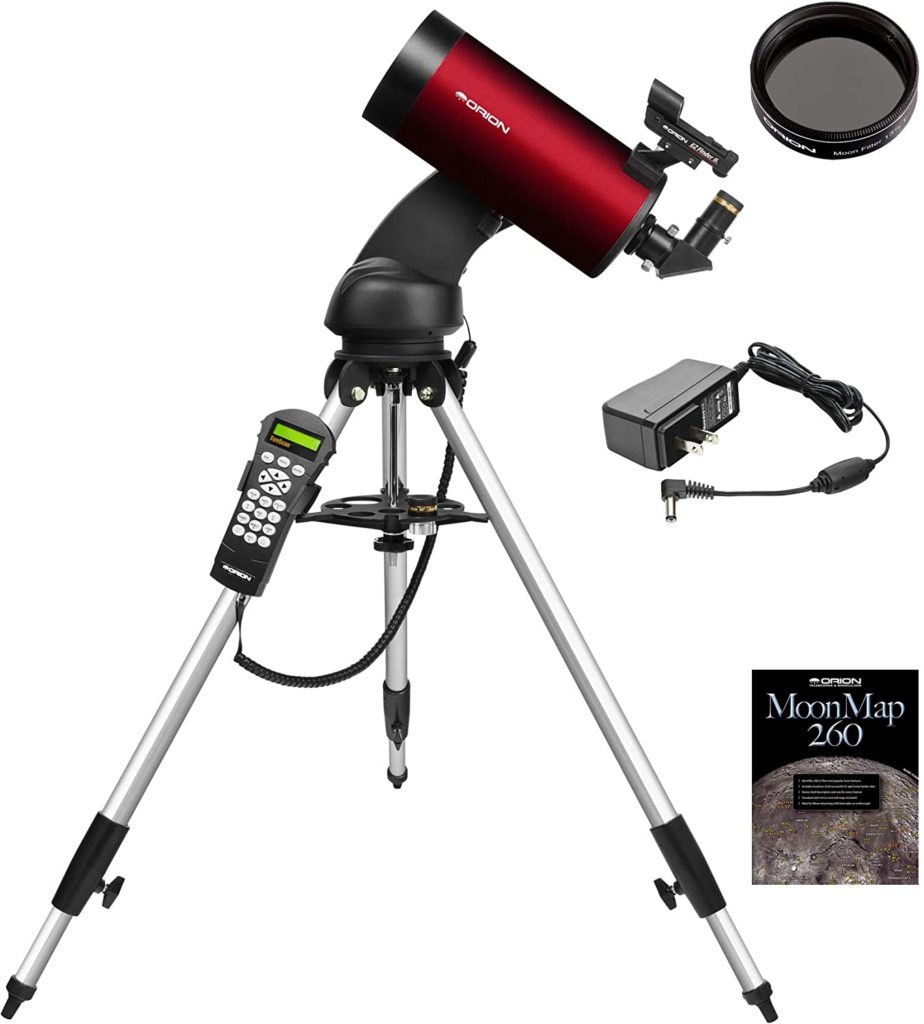
Thanks to its combination of substantial aperture and long focal length, this telescope yields super-sharp resolution at high magnifications, making it an ideal instrument for high-power views of objects in the night sky.
It delivers exceptional views of the Moon’s cratered surface, and by its ability to reveal subtle features on planets like Jupiter, Saturn and Mars.
Deep-sky objects such as nebulas, star clusters, and brighter galaxies are also well within range of this compact power-performer.
The StarSeeker IV 150mm GoTo Mak-Cass lets you explore the skies with pushbutton ease thanks to its GoTo hand controller.
With a vast database of over 42,000 celestial objects including stars, double stars, galaxies, nebulas, star clusters, and more, the included computerized GoTo hand controller will become your tour guide to the skies. The built-in “Tour” mode will show you great sights on any clear night.
The SynScan V4 handset provides two alignment options, brightest star and two star.
Brightest star means you can choose are area of sky from the menu and it will offer a selection of stars to align on based on the date and time.
Two-star alignment allows you to select any star for the first alignment star.
The alignment options worked well depending on how far apart the initial alignment stars are from each other, with best results with stars separated by around 60º.
The single arm fork mount is sturdy and easily attaches to the tripod via three bolts.
Its curved arm allows the telescope tube to aim towards the zenith without catching on the mount’s base, giving you full access to all the sky.
The stainless steel tripod provides good support to the mount and telescope tube.
Pros:
- High-resolution views of the Moon, planets, and deep-sky objects
- Huge GoTo database of over 42,000 objects
- Lightweght & compact
- Comes with a Moon map
Cons:
- Great for imaging Moon & planets
Best For Deep Sky Objects
Orion 9825 Apex 127mm
- Type: Maksutov-Cassegrain
- Aperture: 127mm (5″)
- Focal length: 1540mm
- Focal Ratio: f/12.1
- Mount: Push To: Dobsonian
- Eyepiece: 25mm
- Magnification: 61x
- Weight: 8.6 lbs.(3.9 kg)
- Our Rating: 9.4/10
The Orion Apex 127mm Maksutov-Cassegrain Telescope boasts big 127mm (5″)-diameter optics but in a telescope tube that’s a fraction of the length (just 14.5″ long) and weight (8.6 lbs.) of a Newtonian reflector or refractor telescope of similar aperture and focal length.
Being a Maksutov-Cassegrain, the Apex 127 seldom needs collimation – though the rear cell has screws if you ever must do so. The optical quality of the Apex, like most Maksutovs, is superb. It is great for lunar, planetary, and double star viewing.
The Apex 127 focuses with the same moving-mirror system most catadioptrics use, and comes with a Maksutov-thread visual back, though you can buy an adapter to use Schmidt-Cassegrain threaded accessories.
The 1.25” visual back included has built-in T-threads to attach your DSLR camera, which makes it one of the best intermediate Maksutov Cassegrain telescope for astrophotography.
It gulps in 55% more light through its multi-coated, 5″ meniscus lens than that of a 4″ telescope, putting it in the big leagues for astronomical observation and advanced nature study.
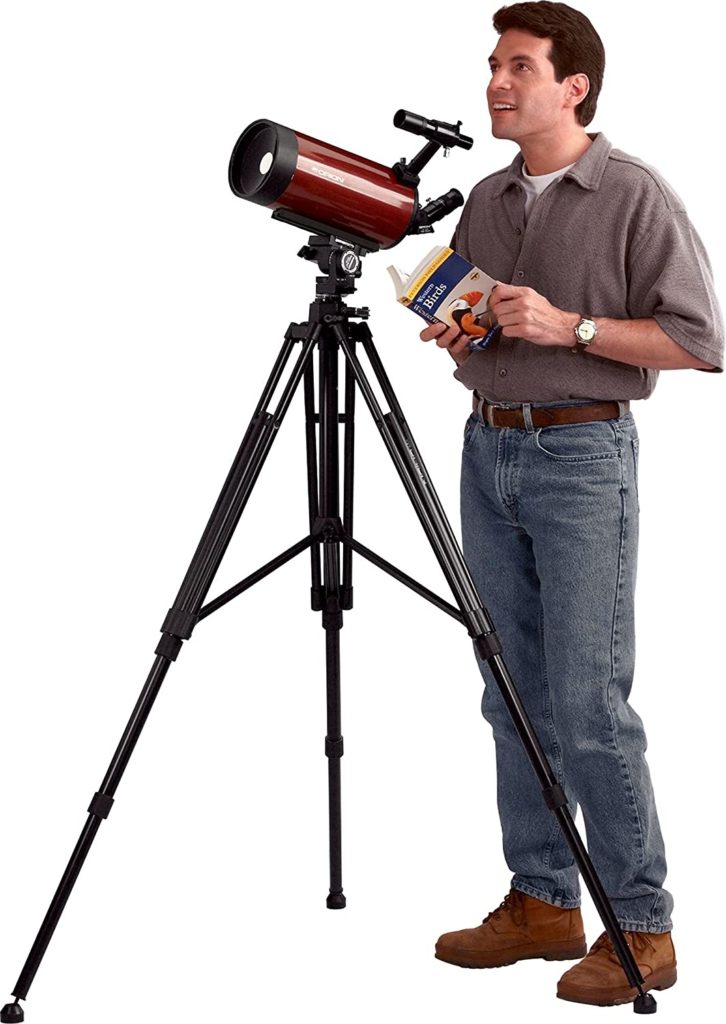
Its long 1540mm (f/12.1) focal length provides 62x magnification with the included 25mm Sirius Plossl telescope eyepiece (1.25″), and lets you push the power up to 250x with optional eyepieces.
You can enjoy bright views of star clusters and nebulae at low power, stunning lunar and planetary detail with this higher powered telescope.
The telescope’s excellent quality is evident not only in the optics of the Apex 127 mm Maksutov-Cassegrain, but also in the black-anodized aluminum front and rear castings, the smooth-turning focus knob, and the extruded aluminum tube, with a classy, metallic-burgundy finish. The included 6×26 achromatic, correct-image finder scope features a quick-release aluminum bracket with a dovetail base and two-screw X-Y alignment. For great daytime views with proper left/right and up/down orientation, the included 25 mm Sirius Plossl telescope eyepiece slips into a 45-degree correct-image prism diagonal, which is also included.
It comes with a Starry Night astronomy software and a fully padded, nylon/polyester telescope carrying case for easy transportability, it also includes a one-year limited warranty.
Pros:
- Collects good amount of light
- Great for day-time as well as night sky viewing
- A perfect grab-and-go option
- Good for lunar & planetary astrophotography
- Comes with a travel case
Cons:
- Does not include a mount
Conclusion
Our top pick for the best maksutov cassegraoin telescope is the Celestron – NexStar 127SLT. Designed as an entry- to mid-level astronomical observation platform, the Celestron NexStar 127SLT 127mm f/12 Maksutov-Cassegrain GoTo Telescope gives users the ability to make detailed observations of the Moon, with the ability to easily see planets and reach outside the solar system to resolve distant objects like galaxies, nebulae, and binary or variable stars.
Our next pick is the Orion 9969. Orion 180mm Maksutov-Cassegrain Telescope sets a new standard for superb high-power performance in a remarkably compact design. With 7″ of aperture and that long focal length Maksutov aficionados love, you’ll get tack-sharp, high-contrast views and clearly defined photos with subtle detail.
Our next pick for the best maksutov cassegrain telescope is the Orion 9820 Apex. With 90mm (3.5″) aperture Orion 9820 provides long focal length performance in a conveniently compact instrument. 90mm aperture and 1250mm focal length Maksutov-Cassegrain optics for fantastic celestial and terrestrial views, especially at higher powers.
ABOUT US
We are a team of active amateur astronomers, here to help you with all your astronomy and science related needs – this is anything, from reviewing the latest telescopes to be released to talking about gravity and neurons. The Big Bang Optics was started because of our love for astronomy and to help others like us find the best telescope and accessories.
LEGAL DISCLAIMER
The Big Bang Optics is a participant in the Amazon Services LLC Associates Program, an affiliate advertising program designed to provide a means for sites to earn advertising fees by advertising and linking to Amazon.com. The Big Bang Optics also participates in affiliate programs with Clickbank and other sites. The Big Bang Optics is compensated for referring traffic and business to these companies.

